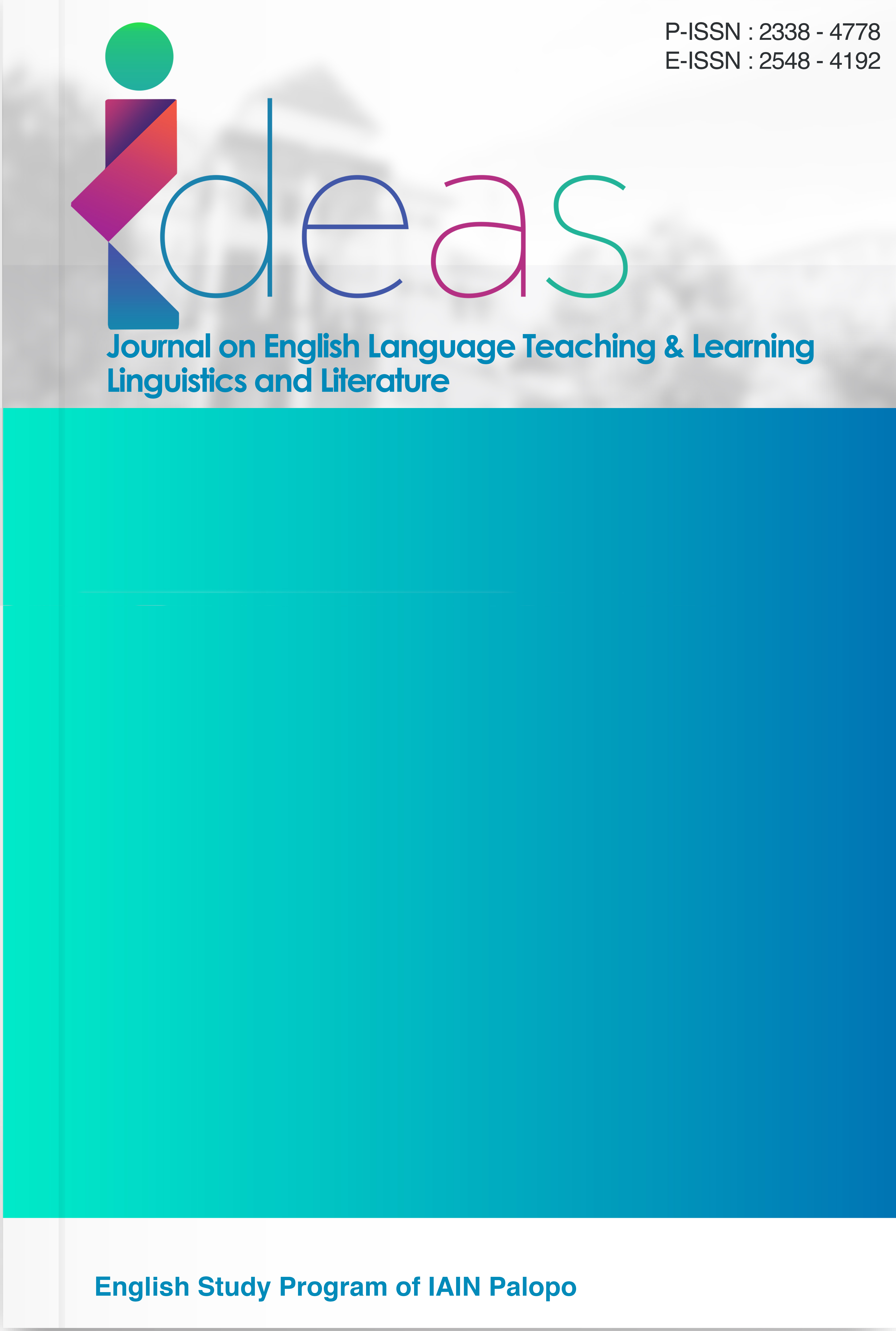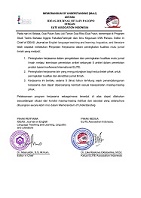Switching Among Worlds: How Online Friends Encourage Code-Switching in Communication
DOI:
https://doi.org/10.24256/ideas.v13i2.6826Keywords:
code-switching; bilingual; digital communication; WhatsApp; DiscordAbstract
This study investigates code-switching in digital communication among bilinguals, focusing on informal conversations on WhatsApp and Discord. It aims to examine the types of Code-Switching that occur and the underlying motivations behind them. The study employs a qualitative case study approach, the research involved chat data analysis and semi-structured interviews with a 21-year-old Indonesian and an 18-year-old Malaysian, both of whom are online friends. Data were collected over a three months period (January-March 2025). Guided by Poplack’s typology, the analysis identified three types of code switching: intra-sentential, inter-sentential, and tag-switching with intra-sentential switching being the most frequent (76% of all instances). Participants reported that their language choices were influenced by social dynamics, emotional state and the context of the conversation. Reasons for code-switching were for expressive clarity, social connection and cultural identity reinforcement. While limited by its small sample and short timeframe, this study highlights how digital platforms facilitate linguistic flexibility and position Code-Switching as a strategic tool for interpersonal communication. The findings contribute to the fields of sociolinguistic and digital communication by providing insight into how online communication shapes multilingual practices in contemporary context.
References
Alice Evangaline Jebaselvi, C., Mohanraj, K., Thangamani, A., & Ramesh Kumar, M. (2023). The impact of social media on the evolution of language and communication trends. Shanlax International Journal of English, 12(1), 41–44. doi:https://doi.org/10.34293/english.v12i1.6725
Androutsopoulos, J. (2013). Networked multilingualism: Some language practices on Facebook and their implications. International Journal of Bilingualism, 19(2), 185–205. doi:https://doi.org/10.1177/1367006913489198
Badan Pengembangan dan Pembinaan Bahasa. (2019). Statistik bahasa daerah. Retrieved from https://petabahasa.kemdikbud.go.id
Beatty-Martínez, A. L., Navarro-Torres, C. A., & Dussias, P. E. (2020). Codeswitching: A bilingual toolkit for opportunistic speech planning. Frontiers in Psychology, 11. doi:10.3389/fpsyg.2020.01699
Braun, V., & Clarke, V. (2006). Using thematic analysis in psychology. Qualitative Research in Psychology, 3(2), 77–101. doi:10.1191/1478088706qp063oa
Caballero, N., & Celaya, M. L. (2019). Code-switching by Primary School Bilingual EFL Learners: A study on the effect of proficiency and modality of interaction. International Journal of Bilingual Education and Bilingualism, 25(1), 301–313. doi:10.1080/13670050.2019.1671309
Catherine P. Blanco. (2024). Code-switching, social interactions, and supportive environment: Addressing the challenges in speaking English. Journal of English Language Teaching and Applied Linguistics, 6(4), 202–209. doi:10.32996/jeltal.2024.6.4.22
Darginavičienė, I., & Ignotaitė, I. (2020). Code-switching in the computer-mediated communication. RUDN Journal of Sociology, 20(2), 405–415. doi:10.22363/2313-2272-2020-20-2-405-415
Daulay, S. H., Nst, A. H., Ningsih, F. R., Berutu, H., Irham, N. R., & Mahmudah, R. (2024). Code switching in the social media era: A linguistic analysis of Instagram and TikTok users. Humanitatis : Journal of Language and Literature, 10(2), 373–384. doi:10.30812/humanitatis.v10i2.3837
De la Fuente, T. E. (2023). Code-switching as a linguistic resource in an EFL Context at a Language Center in Mexico. Erudita: Journal of English Language Teaching, 3(2), 106–118. doi:10.28918/erudita.v3i2.2152
Dewey, M. (2007). English as a lingua franca and globalization: An interconnected perspective. International Journal of Applied Linguistics, 17(3), 332–354. doi:10.1111/j.1473-4192.2007.00177.x
Elhija, D. A. (2023). Code switching in digital communication. Open Journal of Modern Linguistics, 13(03), 355–372. doi:10.4236/ojml.2023.133021
Goh, E., & Wu, H. (2024). Code-switching in computer-mediated communication by Gen Z Japanese Americans. Linguistics Vanguard, 10(1), 615–628. doi:10.1515/lingvan-2024-0031
Herring, S. C. (2018). The coevolution of computer-mediated communication and computer-mediated discourse analysis. Analyzing Digital Discourse, 25–67. doi:10.1007/978-3-319-92663-6_2
Kheder, S., & Kaan, E. (2021). Cognitive control in bilinguals: Proficiency and code-switching both matter. Cognition, 209, 104575. doi:10.1016/j.cognition.2020.104575
Ladzekpo, G. K., Amekor, C. K. A. K., & Akrobotu, M. (2023). Language and Communication in the Digital Age: The Study of How New Technologies and Digital Media are Affecting Language Use, Communication Patterns, and Sociolinguistic Dynamics. Journal of Literature and Linguistics Studies, 1. doi:https://doi.org/10.61424/jlls.v1i1.33
Mefareh Almelhi, A. (2020). Understanding code-switching from a sociolinguistic perspective: A meta-analysis. International Journal of Language and Linguistics, 8(1), 34. doi:10.11648/j.ijll.20200801.15
Moradi, H., & Chen, J. (2022). Attitude-behavior relation and language use: Chinese-english code-switching and code-mixing among Chinese undergraduate students. Sage Open, 12(4). doi:10.1177/21582440221142287
Otheguy, R., García, O., & Reid, W. (2015). Clarifying translanguaging and deconstructing named languages: A perspective from linguistics. Applied Linguistics Review, 6(3), 281–307. doi:10.1515/applirev-2015-0014
Razali, G., Novianty, S. M., Putri, S. T., Nurwardana, J. R., & Utoyo, A. W. (2024). Code-switching communication and cross-cultural identity among urban adolescents in post-colonial Jakarta: A phenomenological study. Journal of Digital Media Communication, 3(2), 66–72. doi:10.35760/dimedcom.2024.v3i2.11715
Roslan, A. N., Mahmud, M. M., & Ismail, O. (2021). Why code-switch on WhatsApp? A quantitative analysis of types and influences of code-switching. Asian Social Science, 17(10), 43. doi:10.5539/ass.v17n10p43
Sudarsono, S. (2021). Code-switching: study on the speech of Indonesian Javanese educated bilinguals. Lire Journal (Journal of Linguistics and Literature), 5(2), 214–232. doi:10.33019/lire.v5i2.130
Tarigan, K. E., Gurning, B., & Simamora, R. M. (2024). Code switching and mixing among students at Catholic University of Saint Thomas. Journal of Linguistics, Culture and Communication, 2(2), 243–264. doi:10.61320/jolcc.v2i2.243-264
Voida, A., Mynatt, E. D., Erickson, T., & Kellogg, W. A. (2004). Interviewing over instant messaging. CHI ’04 Extended Abstracts on Human Factors in Computing Systems, 1344–1347. doi:10.1145/985921.986060
Wei, L., & García, O. (2022). Not a first language but one repertoire: Translanguaging as a decolonizing project. RELC Journal, 53(2), 313–324. doi:10.1177/00336882221092841
Williams, A., Srinivasan, M., Liu, C., Lee, P., & Zhou, Q. (2020). Why do bilinguals code-switch when emotional? insights from immigrant parent–child interactions. Emotion, 20(5), 830–841. doi:10.1037/emo0000568
Wintner, S., Shehadi, S., Zeira, Y., Osmelak, D., & Nov, Y. (2023). Shared lexical items as triggers of code switching. Transactions of the Association for Computational Linguistics, 11, 1471–1484. doi:10.1162/tacl_a_00613
Downloads
Published
Issue
Section
Citation Check
License
Copyright (c) 2025 Rainata Gracia, Syamdianita, Aridah, Maria Teodora Ping, Iwan Setiawan

This work is licensed under a Creative Commons Attribution-ShareAlike 4.0 International License.
Authors retain copyright and grant the journal right of first publication with the work simultaneously licensed under an Attribution-ShareAlike 4.0 International (CC BY-SA 4.0) that allows others to share the work with an acknowledgement of the work's authorship and initial publication in this journal.
Authors are able to enter into separate, additional contractual arrangements for the non-exclusive distribution of the journal's published version of the work (e.g., post it to an institutional repository or publish it in a book), with an acknowledgement of its initial publication in this journal.
Authors are permitted and encouraged to post their work online (e.g., in institutional repositories or on their website) prior to and during the submission process, as it can lead to productive exchanges, as well as earlier and greater citation of published work (See the Effect of Open Access)




